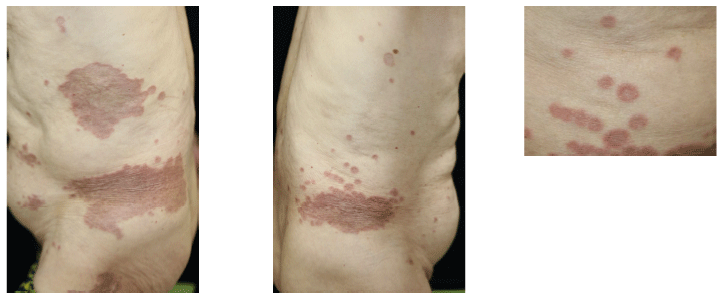
Case Report
Austin J Dermatolog. 2022; 9(1): 1101.
Malignancy-Associated Generalized Granuloma Annulare in a Japanese Patient with Stomach Cancer and Diabetes Mellitus
Yokoyama K, Ikeda T and Kawakami T*
Division of Dermatology, Tohoku Medical and Pharmaceutical University, Sendai, Japan
*Corresponding author: Tamihiro Kawakami, Division of Dermatology, Tohoku Medical and Pharmaceutical University, 1-15-1 Fukumuro, Miyaginoku, Sendai, Miyagi 983-8536, Japan
Received: February 04, 2022; Accepted: February 15, 2022; Published: February 22, 2022
Introduction
Granuloma annulare is a benign granulomatous dermatosis with variable clinical presentation. It is of unknown origin and results in erythematous, brown, or skin-colored annular plaques usually found over boney surfaces on the extremities. The main variants are localized granuloma annulare, subcutaneous granuloma annulare, perforating granuloma annulare, and generalized granuloma annulare. Systemic diseases proposed to have an association with granuloma annulare include diabetes mellitus, dyslipidemia, hypothyroidism, and various malignancies. Cohen [1] coined the term ‘malignancy-associated granuloma annulare’ to describe a form of granuloma annulare that is temporally associated with a malignant process, in which the onset of granuloma annulare coincides with the discovery of a previously unsuspected neoplasm or metastatic disease, and the course of the granuloma annulare also parallels that of the tumor. We present a Japanese patient with malignancy-associated generalized granuloma annulare as the first manifestation of stomach cancer based on diabetes mellitus.
Case Presentation
An 86-year-old man with a history of type II diabetes mellitus visited our hospital with generalized eruptions on his extremities and trunk that had developed over a 4-month period. He had concurrent anemia and shortness of breath. On physical examination, asymptomatic yellow-brown to violaceous papules and plaques measuring from 0.5 to 3 cm were distributed predominantly over his extremities and trunk (Figure 1). Histopathological analysis of a skin lesion showed a granulomatous infiltrate composed of lymphocytes, histiocytes and multinucleated giant cells surrounding degenerated collagen in the middle dermis (Figure 2). Routine laboratory analyses revealed increased levels of glucose (125mg/dL) and HbA1c (6.8%), while lipid and thyroid hormone levels were normal, and evidence of anemia including a depressed Hb count (6.5g/dL). Endoscopic examination revealed the presence of stomach adenocarcinoma. We determined that the onset of granuloma annulare coincided with the appearance of stomach cancer. Topical corticosteroids were ineffective.

Figure 1: Multiple brown papules and plaques with depressed centers on the patient’s trunk.

Figure 2: (a) Granulomatous inflammation surrounding foci of altered collagen in the dermis; (b) Numerous multinucleated giant cells (Hematoxylin-eosin stain;
original magnifications: a, ×100; b, ×200).
Discussion
Generalized granuloma annulare, an uncommon variant of granuloma annulare, is seen in middle age or older patients, and presents with a strong tendency toward treatment resistance. Generalized granuloma annulare is defined as a widespread disease with more than ten skin lesions and accounts for 15% of all granuloma annulare patients, typically presenting with widespread annular and erythematous papules and plaques on the trunk and the extremities. Numerous associated diseases have been controversially discussed, most importantly diabetes mellitus, dyslipidemia, thyroid disease, malignancy, and systemic infections. Case reports have been published on the coexistence of malignancy in generalized granuloma annulare patients [2]. Nordmann et al. [3] reported that malignant disease was present in 14 (23%) of 61 patients they observed with generalized granuloma annulare at their dermatological department within the last 20 years, and was the most common complication compared to diabetes mellitus (n=6; 10.5%), hypercholesterolemia (n=5; 8.2%), and hypertriglyceridemia (n=3; 4.9%).
While the pathogenesis of granuloma annulare remains unclear, the most widely accepted hypothesis is that it is a granulomatous immunologic response to an antigen, resulting in the activation of immune mediators [4-6]. Paraneoplastic syndromes result from an immune response to cancer. It is suggested that in the malignancyassociated form of granuloma annulare, some tumor antigens could trigger an immunological response. In addition, some demonstrated that diabetic patients were more frequently involved by the chronic relapsing form of granuloma annulare than nondiabetic patients [7]. In the present case, we suggest that the appearance of malignancy might have triggered generalized granuloma annulare based on diabetes mellitus.
A retrospective, multicenter study in South Korea found a higher prevalence of diabetes mellitus in generalized granuloma annulare patients compared to the general South Korean population [4]. This observation was corroborated by similar findings in a retrospective analysis in which granuloma annulare patients in Taiwan were compared to the general Taiwanese population [5]. We propose that stomach cancer and diabetes mellitus in the present Japanese patient could have triggered generalized granuloma annulare via some immunological response to the cancer.
References
- Cohen PR. Granuloma annulare, relapsing polychondritis, sarcoidosis, and systemic lupus erythematosus: conditions whose dermatologic manifestation may occur as haematologic-associated mucocutaneous paraneoplastic syndromes. Int J Dermatol. 2006; 45: 70-80.
- Shimizu S, Yasui C, Tsuchiya K. Atypical generalized granuloma annulare associated with two visceral cancers. J Am Acad Dermatol 2006; 54: S236- 238.
- Nordmann TM, Kim JR, Dummer R, Anzengruber F. A monocentric, retrospective analysis of 61 patients with generalized granuloma annulare. Dermatology. 2020; 236: 369-374.
- Yun JH, Lee JY, Kim MK, Seo YJ, Kim MH, Cho KH, et al. Clinical and pathological features of generalized granuloma annulare with their correlation: A retrospective multicenter study in Korea. Ann Dermatol. 2009; 21: 113-119.
- Cheng YW, Tsai WC, Chuang FC, Chern E, Lee CH, Sung CH, et al. A retrospective analysis of 44 patients with granuloma annulare during an 11- year period from a tertiary medical center in south Taiwan. Dermatol Sin. 2016; 34: 121-125.
- Setoyama M, Kerdel FA, Byrnes JJ, Kanzaki T. Granuloma annulare associated with Hodgkin’s disease. Int J Dermatol. 1997; 36: 445-448.
- Studer EM, Calza AM, Saurat JH. Precipitating factors and associated diseases in 84 patients with granuloma annulare: a retrospective study. Dermatology. 1996; 193: 364-368.